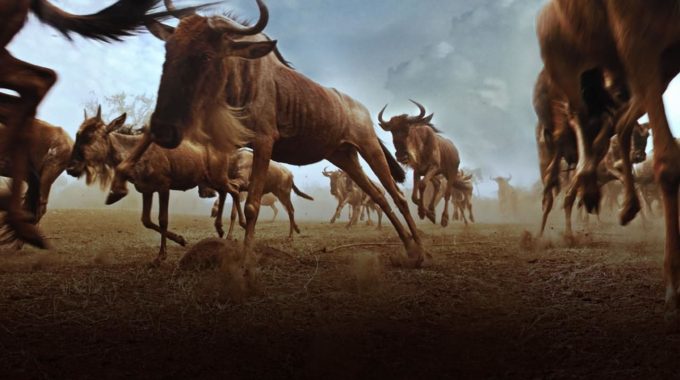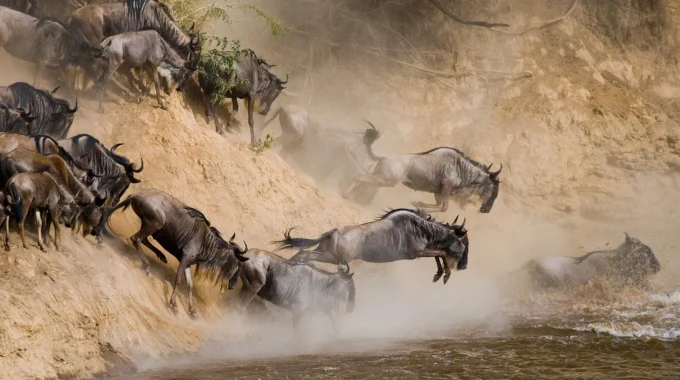A Kenya safari cost can vary significantly based on several factors, such as the season,…
Where is the best place to see the Great Migration in Africa?
Where is the best place to see the Great Migration in Africa? – The Great Migration in Africa, one of the most awe-inspiring wildlife spectacles in the world, primarily takes place in two countries: Kenya and Tanzania. The migration involves the movement of over 1.5 million wildebeest, along with zebras and gazelles, in search of fresh grazing grounds and water. Here are the best places to see the Great Migration:

1. Masai Mara National Reserve, Kenya
- Best time: July to October (especially for river crossings)
- Why it’s great: The Masai Mara is one of the most famous destinations for witnessing the Great Migration. The wildebeest and other herbivores cross the border from Tanzania’s Serengeti into Kenya during this period. The Mara River crossings (where the animals face predators like crocodiles) are particularly dramatic and draw photographers and wildlife enthusiasts from all over the world.
- Key experiences: Game drives, hot-air balloon safaris, and witnessing dramatic river crossings.
2. Serengeti National Park, Tanzania
- Best time: April to June (for the start of the migration) and November to December (for calving)
- Why it’s great: The Serengeti is the epicenter of the migration, where the wildebeest begin their journey. The northern part of the Serengeti, near the Mara River, is especially famous for the crossings into the Masai Mara. The southern Serengeti is renowned for its calving season (January to March), when over 500,000 calves are born in just a few weeks.
- Key experiences: Early migration (April to June), witnessing calving season (January to March), and exploring the Serengeti’s vast plains.
3. Ngorongoro Crater, Tanzania
- Best time: All year round (for resident wildlife)
- Why it’s great: While not directly part of the migration route, the Ngorongoro Crater is a fantastic place to see the wildebeest and other migratory species when they move in and out of the crater. The crater is a year-round wildlife haven, and during the migration, the animals often congregate here, especially in the months leading up to the river crossings.
- Key experiences: Game drives in the crater, incredible wildlife concentration, and stunning landscapes.
4. Grumeti Game Reserve, Tanzania
- Best time: May to June (before the migration crosses into Kenya)
- Why it’s great: The Grumeti River in the western Serengeti (near the Grumeti Game Reserve) is where wildebeest face another set of river crossings before continuing their journey north. Fewer tourists visit this area compared to the Mara, so it offers a more exclusive experience.
- Key experiences: Witnessing river crossings, staying in luxury tented camps, and spotting predators like lions and crocodiles.
5. Mara North Conservancy, Kenya
- Best time: July to October
- Why it’s great: Located just outside the main Masai Mara Reserve, the Mara North Conservancy offers a more private and less crowded experience. The wildebeest herds tend to gather here, and you’ll also have the chance to witness the river crossings in a more intimate setting. The conservation works with the local Maasai communities to promote sustainable tourism.
- Key experiences: Exclusive safaris, hot-air balloon rides, and lesser crowds.
6. Selous Game Reserve, Tanzania
- Best time: June to October
- Why it’s great: While not on the main migration route, the Selous Game Reserve offers a unique experience during the migration. As one of the largest game reserves in Africa, Selous is known for its untamed wilderness, rich wildlife, and fewer visitors. During the migration, some herds can be seen moving through the area as they head north from the Serengeti.
- Key experiences: Boat safaris on the Rufiji River, game drives, and a more remote, off-the-beaten-path adventure.
7. Kogatende, Serengeti (Northern Serengeti), Tanzania
- Best time: July to September
- Why it’s great: This part of the Serengeti is where the wildebeest and zebras make dramatic river crossings over the Mara River, often seen as the pinnacle of the Great Migration experience. It’s one of the most intense wildlife moments on Earth, as predators wait to ambush the herds.
- Key experiences: River crossings, predator action, and witnessing the migration up close in a remote part of the Serengeti.
8. Ruinsori Mountains, Uganda (Rare but spectacular sightings)
- Best time: Rare sighting, but typically May to October
- Why it’s great: While not a traditional migration route, some wildebeest have been spotted moving through parts of Uganda’s Ruinsori Mountains, particularly in areas bordering Tanzania and Kenya. This is a more rare and less commercialized experience.
- Key experiences: Remote wilderness and off-the-beaten-path safari experiences.
Summary of the Best Times:
- Masai Mara, Kenya: July to October (peak river crossings)
- Serengeti, Tanzania: April to June (migration begins) and November to December (calving)
- Ngorongoro Crater: Year-round (resident wildlife, some migration movement)
- Grumeti Game Reserve, Tanzania: May to June (pre-Mara River crossings)
- Mara North Conservancy: July to October (private safaris)
- Selous Game Reserve, Tanzania: June to October (lesser-known migration movement)
- Kogatende, Northern Serengeti, Tanzania: July to September (Mara River crossings)
Conclusion:
For the most dramatic river crossings and iconic migration scenes, Masai Mara (Kenya) and the Mara River crossings in Northern Serengeti (Tanzania) are the best places to experience the Great Migration. If you’re looking for fewer crowds and a more exclusive experience, the Mara North Conservancy in Kenya or Grumeti Reserve in Tanzania may offer a unique, intimate perspective.



